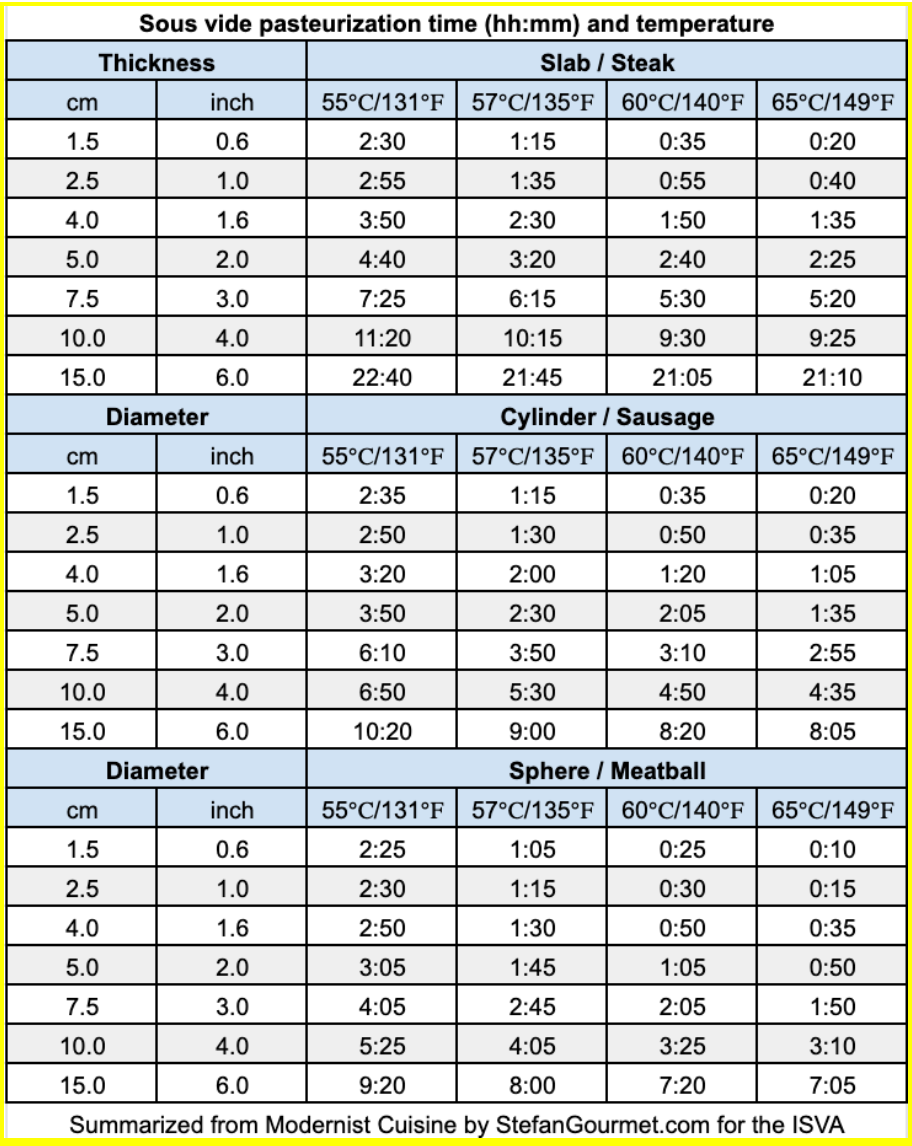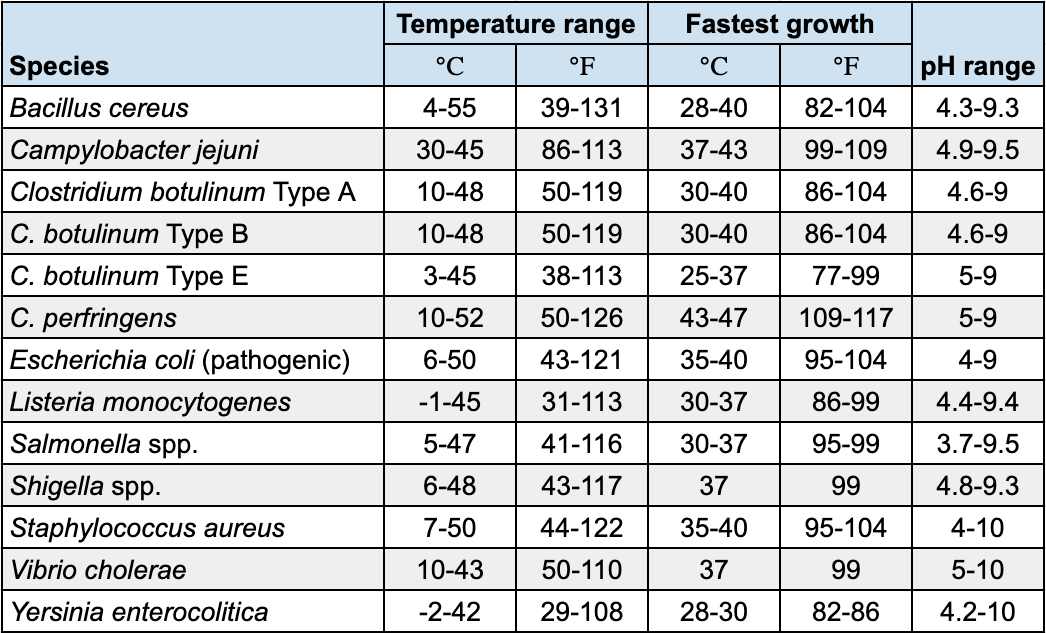Advanced Sous Vide Food Safety
Sous vide is not inherently more dangerous or less dangerous in terms of food safety than other cooking methods, but there is one difference with most (high heat) cooking methods, and that is that more time is not always more safe. When preparing food, it is always safe to assume that pathogens are present on it. The pathogens will grow at temperatures up to about 50C/122F and will start to die (slowly) at temperatures of 52C/125F or higher (the temperatures are actually different for each type of pathogen - see source at bottom of document). This is why food should not be kept above 5C/41F and below 52C/125F, the so-called ‘danger zone’, for more than 4 hours. This includes time transporting the food home, preparing to cook, cooking, and cooling. Those 4 hours have been calibrated on the worst case of the food being constantly around 41C/106F, around which temperature pathogens will multiply at the highest rate. So keeping food for 5 hours at 10C/50F is not by far as unsafe as keeping it for 5 hours at 41C/106F (and may actually still be OK).
Pasteurization means killing most of the pathogens. How safe the food is after pasteurization depends on how many pathogens there were before pasteurization. In general, a reduction of 99.99997% is considered to be pasteurized. This means that of every 3.3 million pathogens that were present before pasteurization, only 1 survives. After the food has been pasteurized, the 4 hour rule is reset to zero. Please note that you can only pasteurize food before it has gone bad. This is because pasteurization only kills the bacteria, not the dangerous toxins that the bacteria could have produced if allowed to grow for more than 4 hours.
All of the information in this article is based upon Modernist Cuisine, which in itself is based upon scientific research. The information is therefore more accurate than simplified ‘rules’ intended for the general public, which often err too much on the side of caution.
Disclaimer: ISVA cannot and does not substitute for legal or health advice about food regulations in any legal jurisdiction, nor can we guarantee that following the information presented by ISVA will prevent foodborne illness. Unfortunately, the many variables associated with food contamination make eliminating all risk and preventing all infections virtually impossible. We cannot accept responsibility for either health or legal problems that may result from following the advice presented by ISVA. If you operate a commercial establishment and serve food to the public, consult the rules and health regulations in your area.
Always observe general food safety guidelines that apply to all kinds of cooking, like washing your hands before handling food, keeping your kitchen clean, watching out for cross-contamination, and storing uncooked proteins in the refrigerator at temperature below 5C/41F.
To pack food for cooking sous-vide, only use food grade bags that are suitable for cooking.
When choosing the time and temperature to cook sous-vide, make sure that the food is not in the ‘danger zone’ of above 5C/41F and below 52C/126F for more than 4 hours, taking into account the accuracy of the thermometer of your water bath as well as the temperature distribution within the water.
If you are cooking at a temperature below 52C/126F, make sure the water has reached the cooking temperature before adding the food.
Intact muscle meat from farmed beef, lamb or pork need only be cooked on the outside to at least 77C/170F. This can be done by searing the meat after cooking sous vide or by immersing the food after vacuum sealing in hot water of at least 77C/170F (boiling water is easiest as you don’t need a thermometer) until the raw color disappears completely (about 10-20 seconds).
Poultry, eggs, ground meat or meat that has in any other way been treated in such a way that pathogens that were on the outside could have ended up on the inside like injecting a marinade, need to be pasteurized before consuming. Use Table 1 to find the correct combination of thickness, time, and temperature to achieve pasteurization.
Fish and shellfish is cooked sous vide at temperatures that will not pasteurize it, as higher temperatures will ruin the fish. This means you should use fish that is so fresh you could it raw (for crustaceans and shellfish this usually means that it is still alive when you start cooking it), and that it is not a good idea to serve it to people with a compromised immune system. It helps to immerse the seafood in hot water after vacuum sealing to kill any microorganisms on the outside, as explained in point 5 above. For inshore saltwater fish it is necessary to freeze the fish before consumption to eliminate parasites (anisakid nematodes).
If you cook food sous vide below 52C/126F (taking into account the accuracy of the water temperature), do not chill and reheat but consume it at once. This is because you were already cooking in the ‘danger zone’. The additional time to chill and reheat will also be in that same zone.
If the food has been cooked long enough to be pasteurized, it is safe to cool and reheat if it is cooled down to below 5C/41F within 2 hours. The food will cool off faster if the bag is put in cold water, even faster if there is also ice in the water. Using ice in the water is important if the food is thick, as otherwise it will take too long for the center to cool off. The time you can store chilled food after pasteurization depends on whether the food was actually vacuum sealed (instead of using a ziploc bag) and on the temperature of your refrigerator: 72 hours below 5C/41F, 30 days at 1C/34F.
If reheating frozen food, reheat sous vide straight from the freezer, or allow to thaw in the refrigerator (not at room temperature) before reheating sous vide. For food safety there is no difference.
The times in Table 1 are calculated by adding the time to heat a protein with the shape and thickness as specified to 1 degree Celcius or 2 degrees Fahrenheit less than the temperature of the water. Then the time to reach a 6.5D reduction of salmonella at 1C/2F less than the indicated temperature is added. As Modernist Cuisine explains, salmonella is the last to die of the pathogens. So if a combination of time and temperature is enough to kill 99.99997% of the salmonella, it will kill even more of other pathogens.
For example, let’s consider a chicken breast with a thickness of 2.5 centimeters (1 inch) that is cooked sous vide at 60C/140F. According to the tables with suggested times for cooking meat and seafood sous vide in Modernist Cuisine, it will take 34 minutes and 31 seconds to heat the core of the chicken breast from 5C/41F to 59C/138F. Then according to the Extended and Simplified 6.5D Salmonella reduction table in Modernist Cuisine, it will take another 17 minutes and 28 seconds to pasteurize at that temperature. So the total time to pasteurize is 51 minutes and 59 seconds. In Table 1 this is rounded up to 55 minutes (for a ‘slab’ of 1 inch at 60C/140F).
Table 1. Time and Temperature for Pasteurization
Table 2 shows the limits within which bacteria can reproduce (source: Modernist Cuisine, Vol. 1, p. 145). They stop reproducing outside of the temperature and pH range shown, and replicate fastest within an optimal temperature range. This table clearly supports that for the most important culprits we are trying to keep at bay when applying sous vide, such as Salmonella, Campylobacter, and E.coli, it is safe to cook sous vide at 52C/126F for as long as you like, because they can’t reproduce at that temperature.
You may notice that Bacillus cereus is however able to reproduce at temperatures up to 55C/131F, which is outside of the danger zone for sous vide cooking as indicated above. This is because Bacillus cereus grows on rice or pasta dishes that have been kept at room temperature for too long, which is quite different from typical sous vide applications. Furthermore, the symptoms of food poisoning by Bacillus cereus are mild. It is however the reason why the safe holding temperature for cooked rice and pasta dishes is above 55C/131F.
Table 2. The Limits of Bacterial Reproduction
Modernist Cuisine, First Edition, 2011, Volume 1, page 190: “the 6.5D reduction curve extends to temperatures lower than 54.4C/130F. Although these parameters are below the threshold recommended by the FDA, they are supported by published scientific research”.


